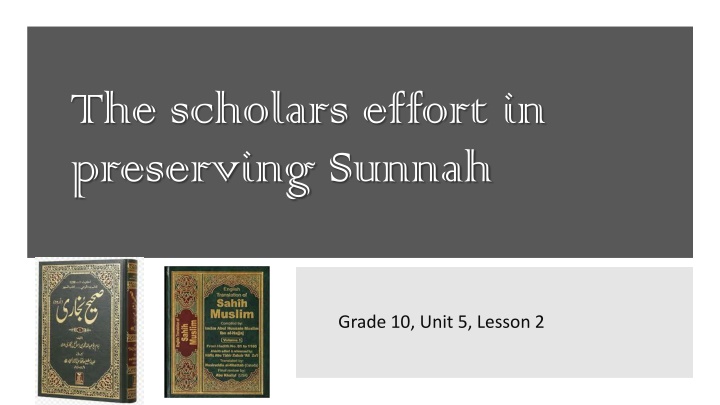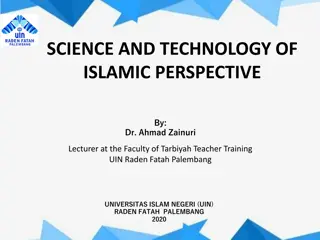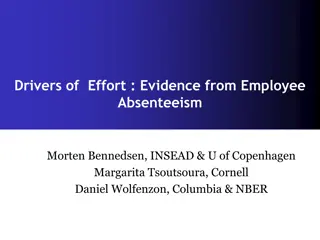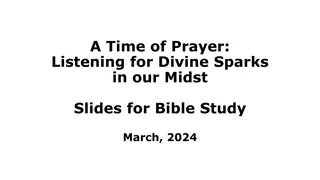The Scholars Effort in Preserving Sunnah: Importance, Hadith, Companions
The scholars' dedication to preserving the Sunnah through Hadith and Isnad, highlighting the importance of understanding key terms and the role of companions like Omar and Abu Hurairah. Explore the methodology of studying narrators, creating a standard for accepting or refuting Hadith. Dive into the motivation by Prophet Muhammad (SAW) to preserve his teachings.
Download Presentation

Please find below an Image/Link to download the presentation.
The content on the website is provided AS IS for your information and personal use only. It may not be sold, licensed, or shared on other websites without obtaining consent from the author.If you encounter any issues during the download, it is possible that the publisher has removed the file from their server.
You are allowed to download the files provided on this website for personal or commercial use, subject to the condition that they are used lawfully. All files are the property of their respective owners.
The content on the website is provided AS IS for your information and personal use only. It may not be sold, licensed, or shared on other websites without obtaining consent from the author.
E N D
Presentation Transcript
The scholars effort in preserving Sunnah Grade 10, Unit 5, Lesson 2
The importance of Hadeeth Allah says: And whatsoever the messenger giveth you, take it. And whatsoever he forbiddeth, abstain (from it). Think & Share!
Keywords Discussion Shariah Sunnah Hadith Isnad Matn Get familiar and understand some basic terms used in science of Hadeeth
Sunnah is the second main source of Sharia. It is divided into two parts: 1. That which is not found explicitly in the Qur an but proven. E.g: praying two rak as for fajar salah. 2. Proven in the Qur an and the sunnah interprets it.
" : " : Motivation by the Prophet (SAW) to preserve his Sunnah ) . : ( Ibn Masud (RA) reportd: I heard the Messenger of Allah (SAW) saying, "May Allah freshen the affairs of a person who hears something from us and communicates it to others exactly as he has heard it (i.e., both the meaning and the words), for it may be that the recipient of knowledge understands it better than the one who has heard it."
The companions (SAHABAH) keenness on preserving Hadeeth Omar (RA) would take turns with his Ansari neighbor to sit in the gatherings of the Prophet (SAW) and teach each other upon their return. Abu Hurairah (RA) also famous for always being in the company of the Prophet (SAW). Think & Explain
Isnad: Chain of Narrators Some key terms used in the science of Hadeeth Muslim scholars exerted great effort to study the reliability of the narrators In the chain of transmitters.
Creating a methodology of studying the chain of narrators and regarding it as a standard for accepting or refuting the Hadith. Among the efforts exerted by the scholars in examining the chain of narrators Examining the method of reporting the Hadith and the utterances used. For e.g: I heard, He read to me, or on the authority of e.t.c.
Distinguishing and classifying them into different categories like: Among the efforts exerted by the scholars in examining the chain of narrators Marfoo (Attributed to the Prophet (SAW). Mawquf ( attributed to a companion) Maqtoo ( Attributed to a successor of one of the companions)
Did research on the narrators themselves. Including but not limited to: Among the efforts exerted by the scholars in examining the chain of narrators Their biographies, Characteristics, status, confidence (accuracy in memorisation) and fairness.
Scholars effort in examining the Matn (text) Setting rules for studying the matn and making a judgment (accept or reject) Distinguishing between Nasikh ( abrogate) and the mansookh ( abrogated) Deduce sharia rulings from it Clarifying complex Hadeeth which common people find hard to understand
It happened at the beginning of the 2nd century (AH). Among the early scholars to record hadeeth were: Imam Abdul Malik bin AbdulAziz bin Jurayj, Imam AbdulRehman Al Awzai, Shu ba bin Al Hajjaj, Hammad ibn Salamah. Then in the 3rd century, some famous Sunnah books appeared such as: Musannas of Abdurrazzaq and the Musannaf of Ibn abi Shaybah Scholars effort in recording Hadeeth
The famous six books know as Sihah as sittah or the six authentic books























